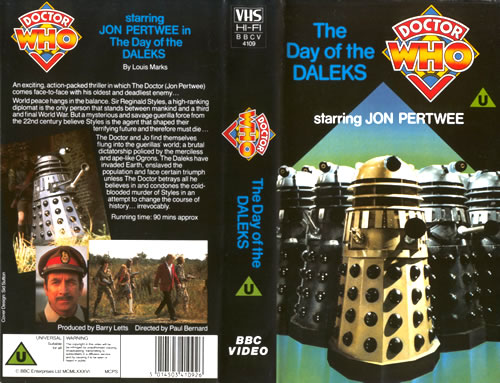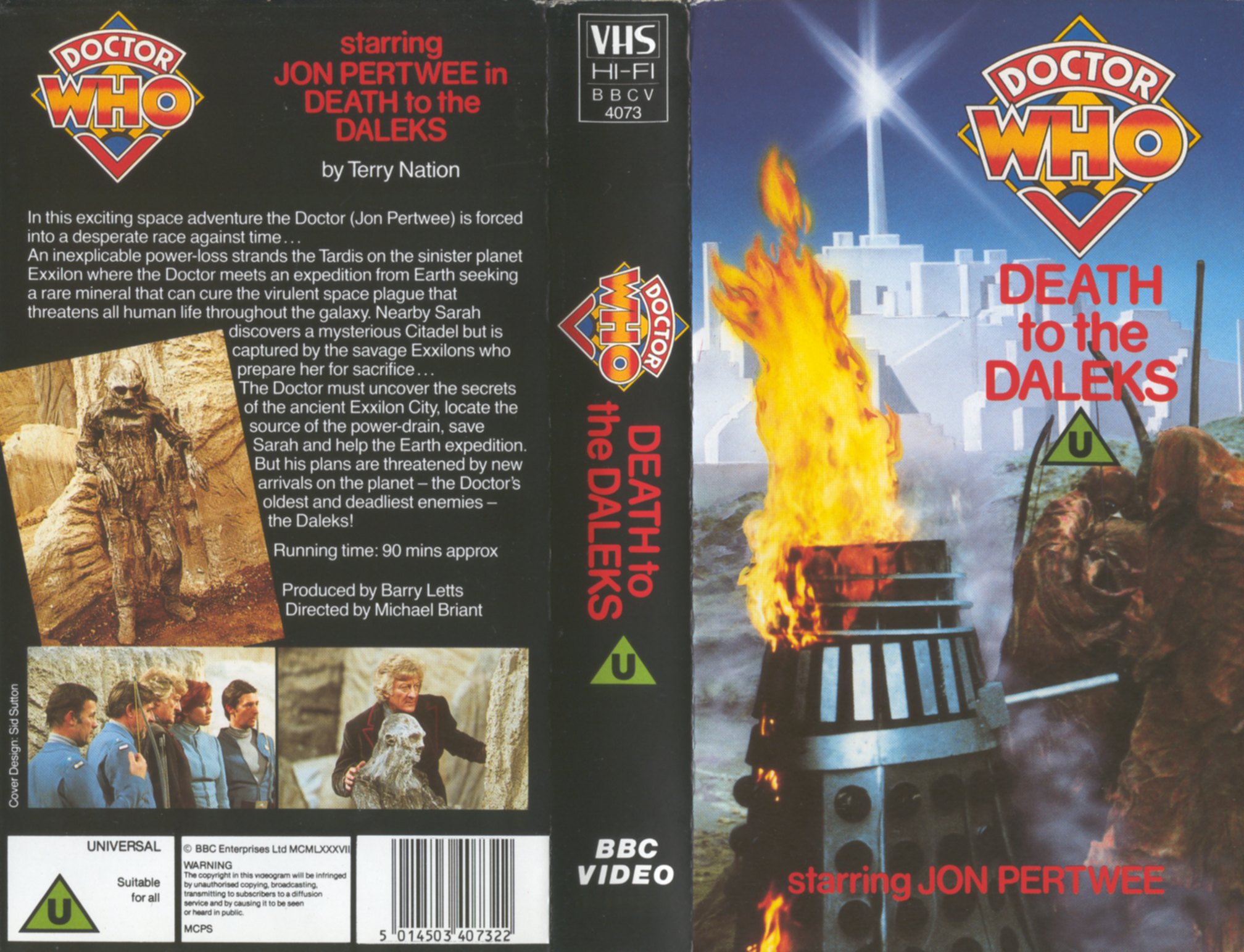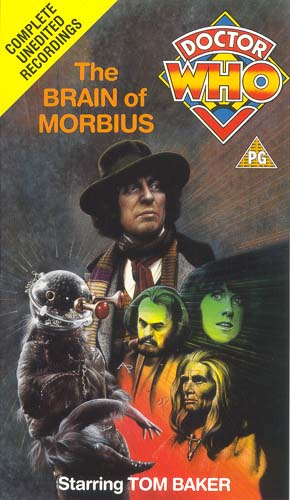Currently we're reaching the end of our Pertwee one-episode-a-night marathon, and I am close to putting all the Pertwee DVDs in order on a shelf barely more than a foot long. Two thoughts come to mind. Firstly, that if it were not for the express purpose of watching all the Pertwee's in order, I would never have thought to purchase a number of them, such as Colony in Space and Death to the Daleks, but I'm glad for having done so. Secondly, that the entire era takes up so little space, approximately 14". VHS on the other hand filled my bedroom as a child, I had no where near the full set and they filled an entire bookcase even when doubled up. They're all gone now, as the DVDs came out they were much easier to store, they had numerous features, the image quality was significantly higher in many cases. I no longer owned a video player, there was just no point to VHS. In the end I sold most of them to some eager young Dr Who fans at a car boot sale for 50p each, they went to a good home. So many VHS cassettes have ended up in landfill, I hope these were watched at least once more.
 |
| False advertising? The story only has three Daleks, one of which was gold. For years the cover persuaded me that there were more. |
Aged about five my Dad bought me my first Doctor Who on VHS. I can't remember which came first, it was either Day of the Daleks or The Daleks. After this I probably had Death to the Daleks, followed by Revenge of the Cybermen and the Time Warrior and other early videos, likely Robots of Death, Seeds of Death. One thing common to most of these early releases is that they were omnibus editions, with the episode breaks removed. This seemed preferable at the time, but on reflection Doctor Who loses a lot from the episodes not being bookended with the cliffhangers. Stories also benefit from being watched episodically, as my Pertwee marathon has found, in a single viewing many come off for the worse being a drawn out slog.
The Daleks was a bit odd in that it came in two cassette boxes, one black and white, the other the same in sepia tones. Almost all double videos afterwards came in a double sized box. The Daleks I recall was gripping stuff, aged five I loved every minute, the black and white didn't faze me one bit. My dad's comment since was that I used to enjoy the radio a lot as a child and that I probably didn't notice the lack of colour. While colour TV was obviously the norm when I was a child 25 years ago, it typically wasn't that good by todays standards, which are a sensory overload of colour and CGI. I wonder if I was unusual as a child, or whether young children today really are less receptive of black and white TV. The Hartnells were only 25 years old then as compared to 50 years now, maybe the gulf has expanded more than I appreciate.
 |
| The iconic moment of Death to the Daleks largely because the exploding Dalek picture was so widely published in early Doctor Who material. Used again on the one of the most memorable Target novels. |
I had Revenge of the Cybermen a bit later which was a novelty as the only available Cyberman story. The alternatives were a bit thin on the ground, even if they delved into the 1980s only Earthshock would have been suitable, Attack and Silver Nemesis are just awful continuity-fests best avoided by anyone. Revenge was the first story to receive an exorbitantly priced home release in 1983 on Betamax, Laserdisk and VHS (with an Earthshock Cyberman). 1984 saw an absurdly butchered release of Brain of Morbius with an hour long running time. By the time I came to the videos, they were being released for a sensible price, around £10 and often cheaper. Revenge was quite entertaining aged six or so and my first exposure to Tom Baker's Doctor. Baker's Doctor spooked me quite a bit, like other children of the 70s I imagine. The scene with the Doctor controlling the Cybermat to force information from Kellman made me uncertain that Tom Baker's Doctor was supposed to be the good guy. I didn't know where he would draw the line.

Various things scared me in these stories available on early VHS, though perhaps not all the most obvious things. The two most frightening were Brain of Morbius and Death to the Daleks. As mentioned, the Exillons were fairly frightening, the story opens in the dark with Sarah especially vulnerable in a marooned, 'dead' Tardis. The loss of that safe haven really does make it seem more frightening, in a normal story there's always the security of being able to flee back to the Tardis. The crew rarely do, but it's a comfort that's always there. That's something that Death to the Daleks actually achieves beyond its many other faults. TO be clear, after the mid way point of episode one it becomes a lot less scary for the most part. Brain of Morbius is similarly scary for being dark and creepy. In that case, I was mostly scared of the Sisterhood oddly enough. Other frightening moments include Harry attempting to stab Sarah with a pitchfork in Terror of the Zygons, the same story in which the world's scariest and bloodstained nurse stoves a soldiers head in with a huge rock.
As years went by the VHS range became more complete and the price crept up. Not unreasonably, but one source of contention was the pricing of double video packs. These seemed contrived for the purpose of charging far more money. Unlike DVDs, little or no restorative work was done on the majority of VHS releases so the running time costs could not have impacted the RRP that much. Talons of Weng-Chiang was first released on a single VHS cassette proving from the beginning that six episodes could be put on a single release. Much later in the VHS range, the Daleks was re-released on a single cassette, all seven episodes together. However, early on it became the norm to split six episode stories across two cassettes in a bigger box and charge £20 for a single story rather than £10. This is the reason that I didn't have many of theses six episode stories, it's was more expensive given the content and the box was unnecessarily about the size of a house brick.
Charging double for stories with six episodes got just a bit silly with the release of Shada. Undoubtedly there were costs involved, but the linking material was scant and ultimately you ended up with piecemeal material for six episodes that barely added up to four episodes. Further was the revelation that, exciting as a never previously seen 'lost' story was, Shada just wasn't very good at all. It's been somewhat fetishised since with multiple attempts to 'complete' it. The New Zealand fan club published a fan novel, Gareth Roberts recently wrote a novel, Big Finish did an audio/webcast and Ian Levine even produced an animated 'reconstruction' with some questionable voice acting. You'll thankfully have to arrange a private viewing to see this last delight.
Back to the original point, the story cuttings with some linking material by Tom Baker was released on VHS at £20. The double boxset was justified by the inclusion of a script book which I doubt anyone ever sat down to read. The 'scriptbook' style font was wearing on the eyes, my copy was especially stiff with coarse paper and the diamond logo-shaped hole in the cover didn't help for easy reading either. Also the book was much slimmer than a VHS, so everything rattled around inside the double cassette box which defeated the point of having a protective case.
Other boxsets were somewhat more interesting but difficult to store as they came in a variety of metal tins and rather highly priced. Trial of a Timelord came in a large Tardis tin, which I kept after discarding the redundant VHS tapes. If you desired consistency in the VHS designs you were in for disappointment. The DVD are mostly uniform and do look smart when lined up together. The VHS releases started with the diamond logo sideways on the sleeve, but later on turned upright, and then the logo changed entirely after the McGann TV movie was released and the BBC decided everything must have the Pertwee/McGann logo. Also with all these boxsets, you ended up with things in tins or in paper sleeves rather than plastic cassette boxes, it all looked a jumble.
 |
| If you never saw this for sale.. |
As previous described the black and white of early stories didn't bother me as a child, no did the overall picture quality, which was atrocious on some releases. The Restoration Team have worked wonders on the DVD range. Recolourisation techniques have improved greatly, Claws of Axos looks good on DVD and Terror of the Autons looks gorgeous. The original VHS releases were very blurry and fuzzy by comparison, it only becomes so apparent after having seen the DVD release. Ambassadors of Death was a very late DVD release and ended up a curious combination of black and white, and colour footage. Episodes would change from one to the other mid way through, the DVD is colour throughout. It's not perfect by a long way but it greatly appreciated, as is the entire colourisation of Mind of Evil and part one of Invasion of the Dinosaurs. The Dæmons was recoloured in 1993, and then cleaned up even more for DVD.

A stand out moment in the VHS range was the return of Tomb of the Cybermen. The importance of this find seemed to enter the mainstream, it was featured in newspapers at the time and went on it be one of the biggest selling of the VHS range. This was in spite of it being rushed to production and looking rough as hell. The DVD release is a huge leap in quality. Be careful what you wish for, a lot of fans seemed disappointed that the classic didn't live up to the mythical hype. A similar reaction was more recently seen with Web of Fear.
As the VHS range wore on I had less and less. This was for several reasons; I seemed to have many of the best ones, added to which I had seen a large number of the remaining stories recorded by a family friend from UK Gold. Lastly, they were getting more expensive, whereas I had got earlier releases for as little as £8, they were now £14 as standard. By comparison, the DVDs now are widely available for £6-7 a few months after initial release even in shops like Forbidden Planet. They're always available, unlike the VHS that appeared for a matter of months before drying up and being unavailable.

UK Gold has its own sets of memories. In the earliest days they only seemed to show the black and white stories on a loop. The person recording the stories occasionally had issues with his reception and the already ropey quality of the Hartnell's was compounded by a snowstorm of interference. The Web Planet, which is supposed to look like it's filmed through a layer of vaseline, was almost unwatchable. Later on they started showing the stories in colour, and later they only showed the colour stories and excluded the Hartnells and Troughtons, just looping from Pertwee to McCoy.
UK Gold sometimes did odd things to mess up the schedule. I distinctly recall watching the Key to Time season for the first time, despite its faults it does get exciting towards the end. I was hoping for all the loose ends to be tied up but upon receiving the video for that week, it turned out that UK Gold had decided to show Planet of the Spiders in place of the Armageddon Factor. While I didn't have a copy of this, it was a bit of a disappointment. The following week was Destiny of the Daleks, meaning Armageddon Factor was skipped entirely. I didn't get to see the last part of the Key to Time until finding the individual VHS for sale quite some time later.
At some point UK Gold started showing one or two episodes of Blake's 7 before each weekend Doctor Who, and it was then I was able to see that series too. The VHS releases covered all my earliest years of watching Doctor Who and were mostly focused around the first four Doctors. In later years I plugged most of the gaps through recordings from UK Gold. It's a real shame that the BBC have been so reticent to repeat any classic Doctor Who. Since it's return in 2005, BBC4 have repeated Hand of Fear after Elizabeth Sladen died, Web of Fear part 1 for a themed London Underground night, and Unearthly Child for the 50th anniversary.


No comments:
Post a Comment